CXC chemokine ligand 16 in periodontal diseases: expression in diseased tissues and production by cytokine-stimulated human gingival fibroblasts
- PMID: 17459077
- PMCID: PMC1942022
- DOI: 10.1111/j.1365-2249.2007.03398.x
CXC chemokine ligand 16 in periodontal diseases: expression in diseased tissues and production by cytokine-stimulated human gingival fibroblasts
Abstract
Periodontal disease is an inflammatory disorder characterized by the involvement of chemokines that are important for the recruitment of leucocytes. Several cytokines are involved in regulating levels of chemokines in periodontal disease. CXCL16 is a chemokine related to the migration of T helper 1 (Th1) cells and natural killer (NK) cells. In this study, we examined its expression in periodontal tissues. Moreover, we investigated the effects of cytokines on the production of CXCL16 by human gingival fibroblast (HGF). Reverse transcription-polymerase chain reaction (RT-PCR) analysis and immunohistochemistry revealed that CXCL16 and its receptor, CXCR6, were expressed at the mRNA and protein levels in diseased tissues. Proinflammatory cytokines [interleukin (IL)-1beta, tumour necrosis factor (TNF)-alpha and interferon (IFN)-gamma] increased the mRNA expression and release of CXCL16 in a dose-dependent manner. Moreover, treatment of HGFs with IFN-gamma in combination with IL-1beta had a synergistic effect on the production of CXCL16. On the other hand, IL-4 and IL-13 inhibited the IL-1beta-induced CXCL16 production by HGFs. Inhibitors of A disintegrin and metalloprotease (ADAM)10 and ADAM17, a recently identified protease of CXCL16, reduced the amount of CXCL16 released from HGFs. These results suggest that the CXCL16 produced by HGFs may be involved in the migration of leucocytes into inflamed tissues, and provide evidence that CXCL16 production is controlled by cytokines in periodontal disease.
Figures
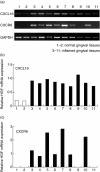
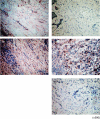
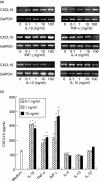
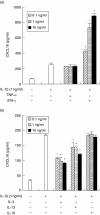
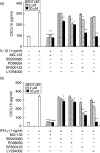
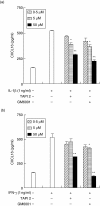
Similar articles
-
CC chemokine ligand 17 in periodontal diseases: expression in diseased tissues and production by human gingival fibroblasts.J Periodontal Res. 2008 Aug;43(4):471-7. doi: 10.1111/j.1600-0765.2007.01080.x. J Periodontal Res. 2008. PMID: 18557811
-
Proinflammatory effects of tumour necrosis factor-like weak inducer of apoptosis (TWEAK) on human gingival fibroblasts.Clin Exp Immunol. 2006 Dec;146(3):540-9. doi: 10.1111/j.1365-2249.2006.03233.x. Clin Exp Immunol. 2006. PMID: 17100776 Free PMC article.
-
Increase of CCL20 expression by human gingival fibroblasts upon stimulation with cytokines and bacterial endotoxin.Clin Exp Immunol. 2005 Nov;142(2):285-91. doi: 10.1111/j.1365-2249.2005.02912.x. Clin Exp Immunol. 2005. PMID: 16232215 Free PMC article.
-
Perspective of cytokine regulation for periodontal treatment: fibroblast biology.J Periodontol. 2003 Jan;74(1):103-10. doi: 10.1902/jop.2003.74.1.103. J Periodontol. 2003. PMID: 12593604 Review.
-
Cytokines and periodontal disease: immunopathological role of interleukins for B cell responses in chronic inflamed gingival tissues.J Periodontol. 1993 May;64(5 Suppl):400-6. J Periodontol. 1993. PMID: 8315562 Review.
Cited by
-
Inflammatory micro-environmental cues of human atherothrombotic arteries confer to vascular smooth muscle cells the capacity to trigger lymphoid neogenesis.PLoS One. 2014 Dec 30;9(12):e116295. doi: 10.1371/journal.pone.0116295. eCollection 2014. PLoS One. 2014. PMID: 25548922 Free PMC article.
-
Oral Dysbiosis in Severe Forms of Periodontitis Is Associated With Gut Dysbiosis and Correlated With Salivary Inflammatory Mediators: A Preliminary Study.Front Oral Health. 2021 Oct 11;2:722495. doi: 10.3389/froh.2021.722495. eCollection 2021. Front Oral Health. 2021. PMID: 35048045 Free PMC article.
-
Human variation in gingival inflammation.Proc Natl Acad Sci U S A. 2021 Jul 6;118(27):e2012578118. doi: 10.1073/pnas.2012578118. Proc Natl Acad Sci U S A. 2021. PMID: 34193520 Free PMC article.
-
Myricetin blocks lipoteichoic acid-induced COX-2 expression in human gingival fibroblasts.Cell Mol Biol Lett. 2014 Mar;19(1):126-39. doi: 10.2478/s11658-014-0186-4. Epub 2014 Feb 25. Cell Mol Biol Lett. 2014. PMID: 24569980 Free PMC article.
-
Influence of Natural Killer Cells and Natural Killer T Cells on Periodontal Disease: A Systematic Review of the Current Literature.Int J Mol Sci. 2020 Dec 21;21(24):9766. doi: 10.3390/ijms21249766. Int J Mol Sci. 2020. PMID: 33371393 Free PMC article.
References
-
- Dzink JL, Tanner AC, Haffajee AD, Socransky SS. Gram negative species associated with active destructive periodontal lesions. J Clin Periodontol. 1985;12:648–59. - PubMed
-
- Socransky SS, Haffajee AD, Cugini MA, Smith C, Kent RL., Jr Microbial complexes in subgingival plaque. J Clin Periodontol. 1998;25:134–44. - PubMed
-
- Kjeldsen M, Holmstrup P, Bendtzen K. Marginal periodontitis and cytokines: a review of the literature. J Periodontol. 1993;64:1013–22. - PubMed
-
- Wilson M, Reddi K, Henderson B. Cytokine-inducing components of periodontopathogenic bacteria. J Periodont Res. 1996;31:393–407. - PubMed
-
- Taubman MA, Valverde P, Han X, Kawai T. Immune response: the key to bone resorption in periodontal disease. J Periodontol. 2005;76:2033–41. - PubMed
Publication types
MeSH terms
Substances
LinkOut - more resources
Full Text Sources
Miscellaneous

